 Facebook
Facebook
 X
X
 Instagram
Instagram
 TikTok
TikTok
 Youtube
Youtube
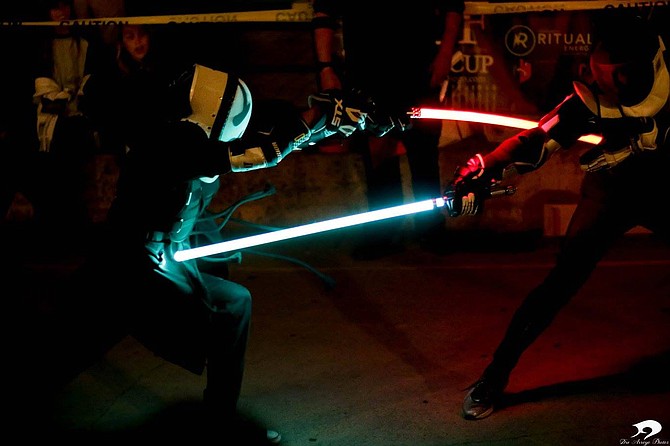
“I feel that if I ask Lucasfilm or Walt Disney [Company] for permission (to use the lightsaber word in the company name),” said Nick Murico, “that might be my Achilles heel.”
When the sun set on March 25, lightsaber-wielding warriors battled one another at the Bea Evenson fountain at Balboa Park. Each competitor tried to slash his/her way through the brackets, to try to win the Underground Lightsaber Fighters Gold Cup.
There were about 75 people present surrounding the sectioned-off “battle arena.” The judges sat on the elevated platform closer to the water, and awarded points to the one-on-one competitors. The first one to strike his or her opponent five clean times, won, and was one step closer to winning the title.
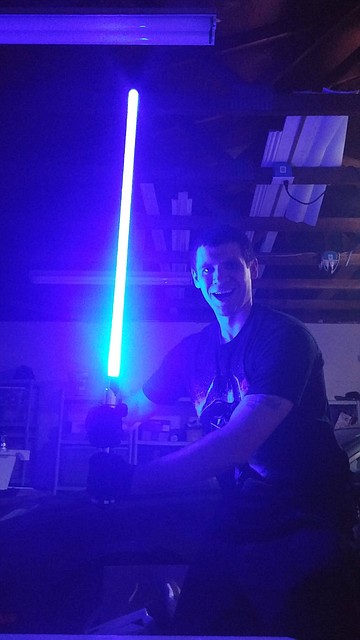
Organizing and judging the lightsaber competition is the fun part for Murico, an East County resident, but he faces a lot more potential battles than other “combat sport” organizers.
“You see, the words 'lightsaber' and 'Jedi' are copyrighted,” said Murico, “that is the problem, and if [Lucasfilm or the Walt Disney Co.] come and try to shut me down with a cease and desist, I think I will be ready.”
Lucasfilm and the Walt Disney Co. are both known to go after those that commit copyright infringement on their brands. This includes other lightsaber-based businesses.
Last October, New York Jedi and Lightsaber Academy were sued by Lucasfilm. The East Coast companies taught lightsaber classes just like Murico does (at the LionHeart Academy in El Cajon). “But they (New York Jedi and Lightsaber Academy) kept going even after they were warned and hit with cease and desist orders,” Murico said.
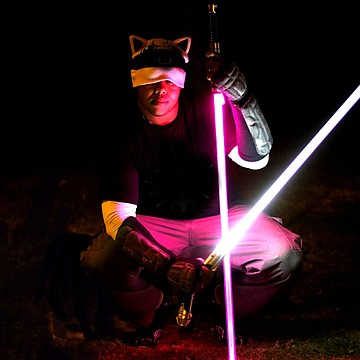
Murico is aware that because he is using the word “lightsaber” on his events and organization, he might be next. He said that he is prepared though, and he’s got his armor in place.
“They (Lucasfilm and or the Walt Disney Co.) don’t have anything better to do than chase small fries,” Peter John said, “they are an Earth’s version of Darth Vaders; the empire equals the money, and the cosplayers are the rebels.”
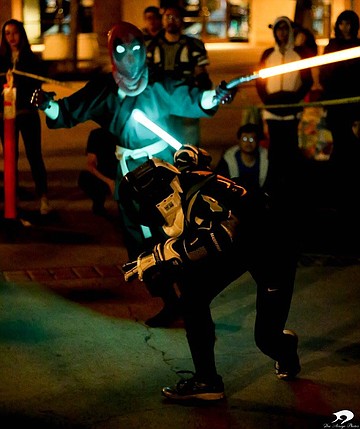
Peter hangs out at Balboa Park to take photos and always photographs cosplayers (costume designers and wearers) playing Star Wars characters. He is an artist that battle damages (with a soldering iron and an airbrush) licensed Star Wars toy spaceships and figures, and sells them at comic conventions. This week he is prepping his pop-art for Wondercon. “They (Murico and his friends) can also change their name to ‘space-sword-fighting’ or ‘cosmic fencing,'” he added, “but it won’t sound so cool.”
Murico is already thinking ahead and has backup names that he cannot reveal. He has other options too.
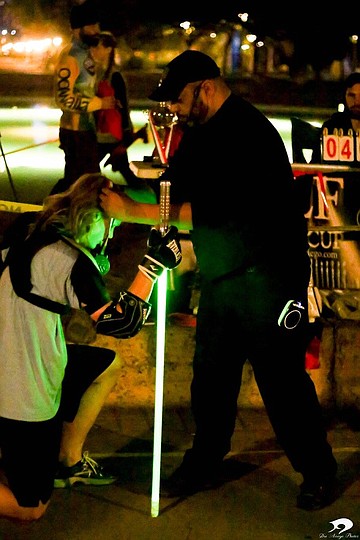
“I’ll strike a deal with them,” he said, “give them a cut and not fight it out with them like the other companies. If that does not work, I’ll hopefully be absorbed by them.”
Murico defines his Underground Lightsaber Fighter (ULF) brand as a “method of operation” and said that it’s different than other lightsaber companies. It’s a meld of pop-culture and combat sport promoted via social media — “think of fencing with giant glow sticks,” said one of the purveyors at the tournament.
Murico founded the ULF a little over a year ago. “When it rains it’d be great to have a roof over our head, but renting a venue is way out of our budget. Advertising, permits, insurance, all these things I cover myself and try and make up the difference with lightsaber sales.”
Lightsabers were originally coined in the Star Wars movies. They were a laser shaped as a blade that would emit with a push of the button on the hilt (the bottom section of the sword) and in the movies, the fighters would use the lightsabers to cut through almost anything in its path (with the exception of another lightsaber). In simulated saber combat though, the faux lightsaber is mostly made of lit-up plastic, which still can sting with a good whack; which is why the ULF competitors wear protective gear. It is mandatory for a fighter that enters Murico’s tournament to use a mask, gloves and shoes. Knee pads, shin guards, a groin cup, and elbow, forearm, and torso protection are optional.
Murico said that the ULF is the only place in San Diego where everyone can come and compete with a crowd to watch, and where prizes are offered to winners.
“The other lightsaber organizations do it for the love of Star Wars,” Murico said, “my tournament entries consist of many warriors that come from martial arts and fencing backgrounds. Me personally, I’m from both sides; I even have a Star Wars tattoo.”


“I feel that if I ask Lucasfilm or Walt Disney [Company] for permission (to use the lightsaber word in the company name),” said Nick Murico, “that might be my Achilles heel.”
When the sun set on March 25, lightsaber-wielding warriors battled one another at the Bea Evenson fountain at Balboa Park. Each competitor tried to slash his/her way through the brackets, to try to win the Underground Lightsaber Fighters Gold Cup.
There were about 75 people present surrounding the sectioned-off “battle arena.” The judges sat on the elevated platform closer to the water, and awarded points to the one-on-one competitors. The first one to strike his or her opponent five clean times, won, and was one step closer to winning the title.

Organizing and judging the lightsaber competition is the fun part for Murico, an East County resident, but he faces a lot more potential battles than other “combat sport” organizers.
“You see, the words 'lightsaber' and 'Jedi' are copyrighted,” said Murico, “that is the problem, and if [Lucasfilm or the Walt Disney Co.] come and try to shut me down with a cease and desist, I think I will be ready.”
Lucasfilm and the Walt Disney Co. are both known to go after those that commit copyright infringement on their brands. This includes other lightsaber-based businesses.
Last October, New York Jedi and Lightsaber Academy were sued by Lucasfilm. The East Coast companies taught lightsaber classes just like Murico does (at the LionHeart Academy in El Cajon). “But they (New York Jedi and Lightsaber Academy) kept going even after they were warned and hit with cease and desist orders,” Murico said.

Murico is aware that because he is using the word “lightsaber” on his events and organization, he might be next. He said that he is prepared though, and he’s got his armor in place.
“They (Lucasfilm and or the Walt Disney Co.) don’t have anything better to do than chase small fries,” Peter John said, “they are an Earth’s version of Darth Vaders; the empire equals the money, and the cosplayers are the rebels.”

Peter hangs out at Balboa Park to take photos and always photographs cosplayers (costume designers and wearers) playing Star Wars characters. He is an artist that battle damages (with a soldering iron and an airbrush) licensed Star Wars toy spaceships and figures, and sells them at comic conventions. This week he is prepping his pop-art for Wondercon. “They (Murico and his friends) can also change their name to ‘space-sword-fighting’ or ‘cosmic fencing,'” he added, “but it won’t sound so cool.”
Murico is already thinking ahead and has backup names that he cannot reveal. He has other options too.

“I’ll strike a deal with them,” he said, “give them a cut and not fight it out with them like the other companies. If that does not work, I’ll hopefully be absorbed by them.”
Murico defines his Underground Lightsaber Fighter (ULF) brand as a “method of operation” and said that it’s different than other lightsaber companies. It’s a meld of pop-culture and combat sport promoted via social media — “think of fencing with giant glow sticks,” said one of the purveyors at the tournament.
Murico founded the ULF a little over a year ago. “When it rains it’d be great to have a roof over our head, but renting a venue is way out of our budget. Advertising, permits, insurance, all these things I cover myself and try and make up the difference with lightsaber sales.”
Lightsabers were originally coined in the Star Wars movies. They were a laser shaped as a blade that would emit with a push of the button on the hilt (the bottom section of the sword) and in the movies, the fighters would use the lightsabers to cut through almost anything in its path (with the exception of another lightsaber). In simulated saber combat though, the faux lightsaber is mostly made of lit-up plastic, which still can sting with a good whack; which is why the ULF competitors wear protective gear. It is mandatory for a fighter that enters Murico’s tournament to use a mask, gloves and shoes. Knee pads, shin guards, a groin cup, and elbow, forearm, and torso protection are optional.
Murico said that the ULF is the only place in San Diego where everyone can come and compete with a crowd to watch, and where prizes are offered to winners.
“The other lightsaber organizations do it for the love of Star Wars,” Murico said, “my tournament entries consist of many warriors that come from martial arts and fencing backgrounds. Me personally, I’m from both sides; I even have a Star Wars tattoo.”
Comments